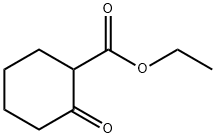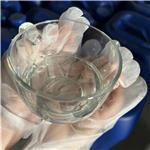Chemical Properties
Clear colorless to pale yellow liquid
Uses
Ethyl 2-Oxocyclohexanecarboxylate is used in biocatalysis.
Uses
Ethyl 2-oxocyclohexanecarboxylate is used to produce other chemicals. For example, it can react with 4-methyl-aniline to get 2-oxo-cyclohexanecarboxylic acid p-toluidide. The reaction occurs with reagent DMAP
Reactions
The reaction of ethyl 2-oxo cyclohexane carboxylate (I) with phenyl vinyl sulphoxide (II) and sodium hydride followed by pyrolysis of the resulting phenyl sulphonyl ethyl compound (III) gives the 1-vinyl compound (IV).
Baeyer-Villiger oxidation of methyl 3- and 4-oxocyclohexanecarboxylates gave the expected hexanolides, whereas ethyl 2-oxocyclohexanecarboxylate(I) gave 5-ethoxyoxalylpentanoic acid by way of ethyl 1-hydroxy-2-oxocyclohexanecarboxylate, formed by epoxidation of the enol form of (I)[1-2].
Synthesis Reference(s)
Canadian Journal of Chemistry, 42, p. 1333, 1964
DOI: 10.1139/v64-205The Journal of Organic Chemistry, 53, p. 878, 1988
DOI: 10.1021/jo00239a038Tetrahedron Letters, 7, p. 2201, 1966
References
[1] A. Hubert, P. S. Starcher. “The Baeyer-Villiger oxidation of alkyl oxocyclohexanecarboxylates.” Journal of The Chemical Society C: Organic 377 1 (1968): 2500–2502.
[2] G. Koppel, M. D. Kinnick. “Phenyl vinyl sulphoxide, a vinyl carbonium ion synthetic equivalent.” Journal of The Chemical Society, Chemical Communications 27 1 (1975): 473–473.






